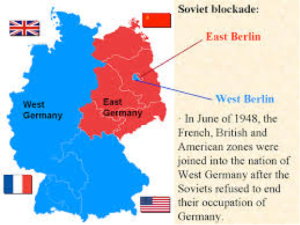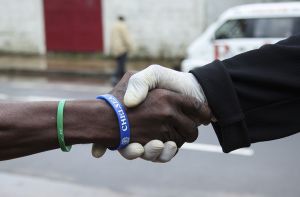This article was selected as the winner of the “Fall of the Wall” writing contest, held by the Department of German and Scandinavian Studies (GSS) at the University of Massachusetts Amherst and funded by the German Embassy. It is to be published by the German Information Center and the GSS sometime later this year.
Introduction
Berlin serves as a microcosm ideal for economic analysis in the 20th Century, having transgressed a distinct divide in economic systems, as well as numerous external disadvantages, to become a budding leader not only in the markets of the European Union (EU), but in the financial, industrial, and service markets of the world at large. This paper will briefly present the economic and political landscape of Berlin before its famous (or infamous) division, and then the city’s subsequent existence as both a social democratic market economy and a centrally planned socialist economy. This paper argues concisely that the distinct division created economic and political adversity that has motivated the people of the German “Hauptstadt” to restore the city to prominence through a combination of investment in innovative research and well-aimed government subsidies created with the purpose of promoting equality between East and West.
Pre-Cold War Berlin
The city of Berlin at the start of the 1940’s boasted an impressive combination of industry, research, and education, being the center of what Hitler envisioned as the seat from which his Germanic world empire would be ruled. Host to over 4.5 million inhabitants, Berlin was among the world’s largest cities before the devastation of World War II reached its borders 1.
Berlin was quickly reduced in stature by sustained, Allied aerial bombardment and by the incursion of Soviet forces in 1945. Housing units in Berlin were reduced by as much as 42%, displacing much of the population, and left communication, transportation, and basic utilities crippled 2. The productive ability of Berlin was nearly crippled, East Berlin suffering an initial loss or displacement of 24% of its population and 22.9% of its industrial capacity (IC), and West Berlin suffering 27% population loss or displacement and 23.5% of its IC; these numbers would only worsen, however, when during the two months of total Soviet occupation, before Allied occupation by the French, British, and American forces began, the Red Army essentially took as reparations or destroyed 67% of West Berlin’s industrial capacity and 33% of East Berlin’s3.
Divided Berlin (1945-89)
The Allies, France, England, and the United States, occupied the Western boroughs of Berlin4, and upon the frontier ranging from Pankow and Reinickendorf to Treptow in the north and Neukölln in the south. The USSR would take the entire Eastern half for itself. In 1948, the country was officially divided, and the Western amalgamation of “Bundesländer” (states) became the Federal Republic of Germany (FRG). The rest of the nation joined the Eastern Bloc, the nations of Eastern Europe united under the hegemony of the Soviets, and became the German Democratic Republic (GDR). This post bellum division left Ally occupied, now democratically governed West Berlin stranded and blockaded on all sides by the USSR5. This blockade took its toll on the Western, social democratic market economy almost immediately, and required the FRG to begin providing the Berlin municipal government with massive subsidies in order to stimulate growth and the survival of its industries. Before the construction of the Berlin Wall in August 1961, the city also bore the burden of acting as a major refugee center. Over 1.8 million Eastern Bloc escapees registered in West Berlin, with all but 190,000 of them flown to West Germany6. The massive influx of refugees may have lead to numerous crises in the region including an uprising in East Berlin in 1953 and food shortages that pushed the FRG to institute nearly complete collective agriculture7.
West Berlin’s innovative processes were existent despite such hardship, and were certainly not above change or influence; their push for experimental economic models was not without affect from its socialist neighbors. One such system was the use of a collective enterprise
model, in which the traditional, hierarchical structure of the firm was broken and authority was more evenly distributed between wageworkers8. Consisting of mainly West German manufacturing businesses and shops, the workers would often take competitive pay cuts in exchange for the authority to take on more tasks than they were assigned if they so chose, and to contribute to projects and decision making responsibilities outside their immediate purview9. These developments were not stemmed in the later years of the division, even after reunification, and continue to thrive in Berlin’s economy today.

Image 2: Berlin was a proverbial island in a Soviet sea, a precarious bastion of capitalism amongst waves of communism.
Despite its status as the most prosperous, non-Russian economy of the Warsaw Pact, East Berlin was still far behind its western counterpart, and lacked wholly any such commitment to fostering innovation. Although the GDR did not provide direct subsidies as the FRG did to West Berlin, the industries of East Berlin enjoyed a number of indirect subsidies10. East Berlin enjoyed an ability to implement “faster and better housing construction, a representative and more consistent architectural and urban design, a better supply of goods for consumption,” earlier than the West, due the GDR central planning, and therefore also had the capacity to provide “skilled jobs which [in turn] promised better career opportunities11.” This initial boost allowed East Berlin to rise to as the premier industrial theater of the GDR, with over 140,000 jobs in electrical technology, electronics, machine construction and light industries, despite the proportion of people working in industry having been less than the GDR’s average12.
By the time of reunification in 1989, East Berlin had experienced a downturn. Secondary sector jobs had fallen by 35%13; the primary and secondary sectors generated only 28% of East Berlin’s GNP despite making up 33.1% of the employment in the city, compared to the primary and secondary sectors of West Berlin which produced 42.1% of GNP despite making up only 31.3% of the workforce14.
The disparities between the two halves of the city, including the concentration of industry jobs, the employment of women by significantly higher numbers in the GDR, and the generally vast difference in two completely distinct economic systems resulted in an unbelievably harrowing, daunting, and ominous opportunity for successful reunification. No such blueprint, no example could be provided to the soon-to-be German Federal Republic on how to integrate an ex-Soviet Bloc nation into its economy. Berlin would serve as the experiment of market fusion.
Transition and Reunification (1990-Present)
The Fall of the Berlin Wall, although symbolically significant as a positive political gesticulation, signaled only a new host of problems on the economic front. Perhaps of greatest concern at this time was a massive rise in Berlin unemployment. Having had nearly the entire eastern population employed by state owned industries of the GDR planned economy, the daunting risk of massive labor surplus loomed in the face of a pending reunification. Unemployment immediately shot up 20 percent by the start of 1990, with passionate labor disputes becoming a staple of frustrated and understandably concerned former-GDR employees15. Although employees in East Germany were at least as well educated “in terms of formal education,” the skills learned and knowledge gained via state owned companies and via an East German education were antiquated and not readily transferable to the market-‐based economy of the new German republic16.
In an effort to stay the impending crisis, a privatization agency known as Treuhand led by West German manager Detlev Carsten Rohwedder, was charged with the task of privatizing 12,000 GDR companies, liquidating unusable or outdated assets, and bearing the monumental burden of keeping millions of East Germans employed17. The Treuhand Trust was valued at about $300 billion Deutschmark (~ 336 billion dollars), easily the largest trust ever formed in human history. Unfortunately, however, the privatization efforts of the new government were mostly unsuccessful in stemming the coming onslaught of economic discord. Rohwedder was assassinated by suspected communist radicals and the Treuhand was disbanded in 19941819.
Berlin’s economic prospects were further diminished. The German government soon discovered that not only had the strength of the planned economy of the GDR been vastly overstated, it would also not be bringing in any of its Eastern Bloc trade relationships, something that had been hoped might foster economic growth in the newly merged nation20. Since the mid-90’s, Berlin’s government has placed an emphasis on both investment and higher education, having seemingly restored the city’s global stature as a thriving research zone. Berlin has exchanged its manufacturing sector basis for an expansive service sector (which now constitutes close to 85% of all employment), and the capital city is now distinguished as among the top three innovative regions in the entire EU, thanks to its numerous higher education institutions over 70 publicly funded R&D institutes, as well as multiple laboratories, technology parks, and incubators21. Berlin spends 4.2% of its GDP on research and development.
The economic division of unified Berlin in the modern day “Bundesrepublik Deutschland” is still far from trivial, however, and the “science-led innovation [has proven] not enough to address the challenges of long-term unemployment and a low absorptive capacity” in
Germany’s economy22.
In economic terms, the former division manifests itself not as one quantifiable variation, but as multiple differences between East and West. Differences between GDP per capita, unemployment, and housing prices are especially indicative of the disparity. Although GDP per capita revenue in East Berlin has reached €23,700, more than double GDP at the time of reunification, West Berlin GDP per capita rose to €33,400, a 30% gap over East Berlin. The government has offered various subsidies, however, in an effort to reduce the differences in purchasing power between East and West23. They are, however, waning in the face of Berlin’s more integrative policies for research funding, continually investing more in the applied sciences per annum24.
Unemployment is still varied between East and West, with nearly 12% in Berlin, compared to less than 6% unemployment to the west25. However, the Gini coefficient suggests that overall, German society is mostly equal since reunification, there being about a 27% inequality gap in the distribution of income26. The differential in prices has led some East Germans who moved West to return East; the move motivated largely by the lower cost of housing is not substantial, however, as the East still cumulatively lost a tenth of its population overall, dropping from 18.1 to 16.3 million since reunification, whereas the West has gained 6%, up from 61.9 to 65.5 million27. Despite these disparities, Berlin has managed, again, to become a regional as well as world leader despite the daunting task of reunification.
Analysis & Conclusion
The task of determining whether reunification was successful depends entirely upon the medium used to judge not only Berlin, but Germany at large. Again, having had no other example in history upon which to compare the process of reunification leaves critics and supporters alike in a difficult situation upon which to declare a defeat or victory. As example and in terms of renovation, nearly every east German city has been updated: the anachronistic, bland concrete Soviet architecture having largely been replaced with more modern edifices, Berlin perhaps being the crown jewel of this endeavor28.
That being stated, the amount of continued subsidy that is being provided to East Berliners and Germans cannot be understated. In 2010, 50% of the $103 billion of subsidies towards development were used for the funding of the social benefits and welfare that were required to protect the East’s substantial population of unemployed workers29. This commitment to protecting the citizenry of the East demonstrates a tenacity and commitment to promulgating the new Berlin, and Germany, to prominence together or not at all. To still be a leader in not only the EU but in the world for research and innovation, and in the financial, industrial, and service markets despite the massive subsidies and harrowing difficulties encountered over the past 20 years is a testament to the Berliner’s ability to adapt, and for the remnants of reunification to go successfully by any such metric it is to be considered by. The people of Berlin have demonstrated, through their commitment to R&D and social protection of all, that success and improvement will be made through perspiration, innovation, and most certainly through the inspiration that their own example sets for the rest of the world.
Endnotes
- Merritt, R. L. “Divided Berlin: One Past And Three Futures.” Journal of Peace Research (1972): 331-44. Web. 13
- Id 331.
- Id 332.
- See App. 1. See also Image 1.
- See Image 2.
- Carpenter, James O. “Berlin.” Sociological Focus Vol. 1, No. 4, Summer, 1968 (1968): 48-‐58. Web. 13 Oct. 2014.
- Id 52.
- Müller, Birgit. Toward an Alternative Culture of Work: Political Idealism and Economic Practices in West Berlin Collective Enterprises. Boulder: Westview, 1991. 1-‐212. 1,9, 15. Print.
- Id 25-45.
- Dangschat, Jens. “Berlin and the German Systems of Cities.” Urban Studies 30.6 (1993): 1025-‐051. 1034.
- Id.
- Id 1036.
- See App. 2.
- See App. 3.
- Wiederwald, Rupert. “Treuhand Took the Heat for Privatization of East German Economy | German Reunification | DW.DE | 20.09.2010.” DW.DE. Web. 15 Oct. 2014. <http://www.dw.de/treuhand-took-the-heat-for-privatization-of-east-german-economy/a-5985015>
- Spitz-‐Oener, A. “Human Capital, Job Tasks and Technology in East Germany after Reunification.” National Institute Economic Review July 2007. 201 (2007): 97-‐106. 97. Web. 13 Oct. 2014.
- Id. Wiederwald 1.
- Sinn, Gerlinde, and Hans Sinn. Jumpstart: The Economic Unification of Germany. Cambridge, Mass.: MIT, 1992. Print. 105.
- Id Wiederwald 2.
- Id Dangschat 1045.
- “Berlin, Germany: Assessment and Recommendations.” OECD Review of Higher Education in Regional and City Development. Organisation for Economic Co-operation and Development (OECD). 4. Web. 15 Oct. 2014. <http://www.oecd.org/edu/imhe/46573473.pdf>.
- Id 5.
- Lemaître, Frédéric. “East-West German Split Still Lingers on 22 Years after Reunification.” The Guardian Weekly 9 Oct. 2012. The Guardian. Web. <http://www.theguardian.com/world/2012/oct/09/west-east-germany-split>.
- Id 7.
- Id.
- “CIA World Factbook: Germany.” Central Intelligence Agency. Central Intelligence Agency. Web. 15 Oct. 2014.
- Id Lemaître.
- Chase, Jefferson. “Reunified Germany Is a Nation of Many Faces and Variable Success.” Web. 15 Oct. 2014. <http://www.dw.de/reunified-germany-is-a-nation-of-many-faces-and-variable-success/a-6025610>.
- Id.
Works Cited
- “Berlin, Germany: Assessment and Recommendations.” OECD Review of Higher Education in Regional and City Development. Organisation for Economic Co-operation and Development (OECD). Web. 15 Oct. 2014. <http://www.oecd.org/edu/imhe/46573473.pdf>.
- Carpenter, James O. “Berlin.” Sociological Focus 1, No. 4, Summer, 1968 (1968): 48-58. Web. 13 Oct. 2014.
- Chase, Jefferson. “Reunified Germany Is a Nation of Many Faces and Variable Success.” Web. 15 Oct. 2014. <http://www.dw.de/reunified-germany-is-a-nation-of-many-faces-and-variable-success/a-6025610>.
- “CIA World Factbook: Germany.” Central Intelligence Agency. Central Intelligence Agency. Web. 15 Oct. 2014.
- Dangschat, Jens. “Berlin and the German Systems of Cities.” Urban Studies6 (1993): 1025-051.
- Lemaître, Frédéric. “East-West German Split Still Lingers on 22 Years after Reunification.” The Guardian Weekly 9 Oct. 2012. The Guardian. Web. <http://www.theguardian.com/world/2012/oct/09/west-east-germany-split>.
- Merritt, R. L. “Divided Berlin: One Past And Three Futures.” Journal of Peace Research (1972): 331-44. Web. 13 Oct. 2014.
- Mueller, Birgit. Toward an Alternative Culture of Work: Political Idealism and Economic Practices in West Berlin Collective Enterprises. Boulder: Westview, 1991. 1-212. Print.
- Sinn, Gerlinde, and Hans Sinn. Jumpstart: The Economic Unification of Germany. Cambridge, Mass.: MIT, 1992. Print.
- Spitz-Oener, A. “Human Capital, Job Tasks and Technology in East Germany after Reunification.” National Institute Economic Review July 2007.201 (2007): 97-106. Web. 13 Oct. 2014.
- Wiederwald, Rupert. “Treuhand Took the Heat for Privatization of East German Economy | German Reunification | DW.DE | 20.09.2010.” DE. Web. 15 Oct. 2014. <http://www.dw.de/treuhand-took-the-heat-for-privatization-of-east-german-economy/a-5985015
Appendix
App. 1: The Boroughs of Berlin
App. 2: Percentage of employees (excluding apprentices), by sectors, East Berlin 1955-89

App. 3: Percentage of employees and value added by sectors, West Berlin and East Berlin, 1990







